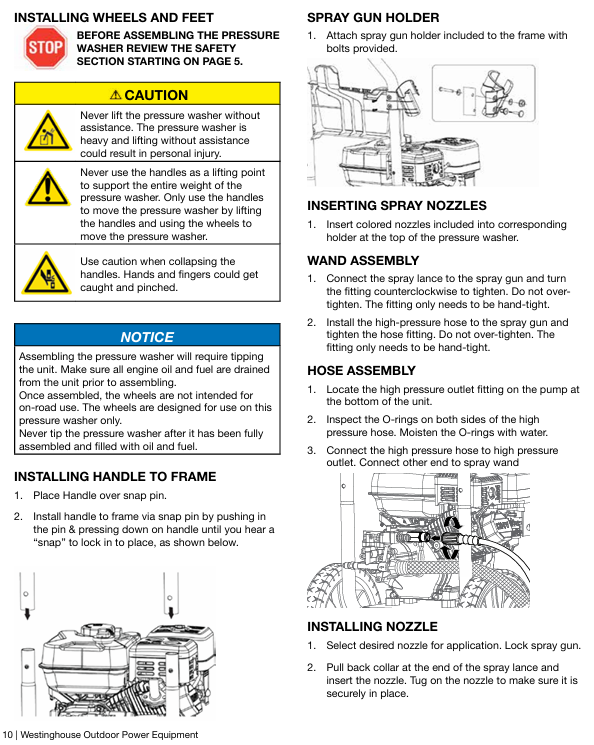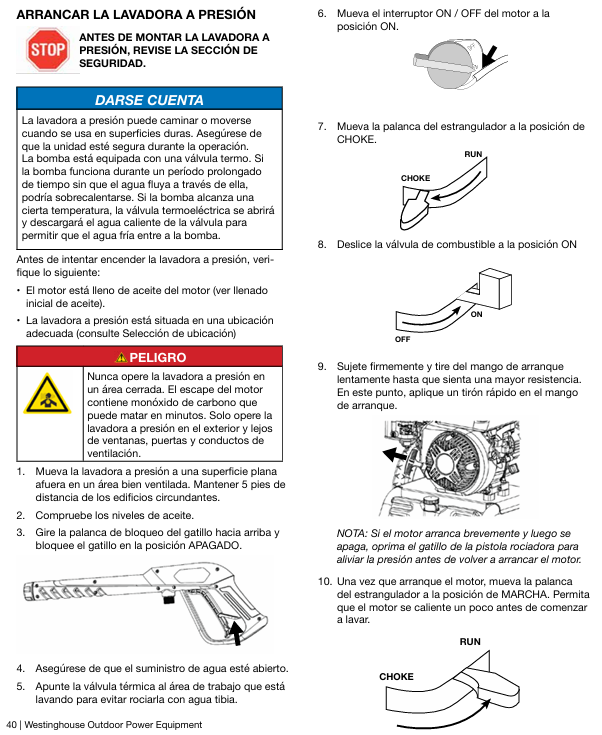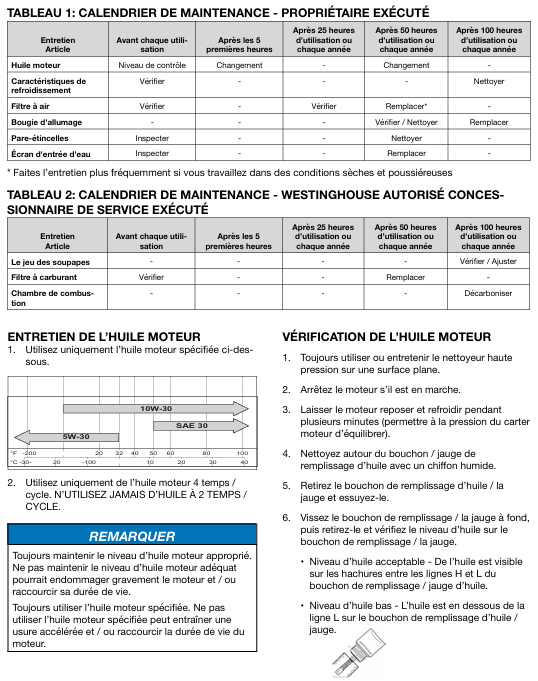

K-WANG


Westinghouse WPX2700H/WPX3100H High Pressure Cleaning Machine
Working pressure 2700PSI (186BAR) 3100PSI (213BAR) The higher the pressure, the stronger the cleaning power, suitable for stubborn stains
Flow rate 2.3GPM (8.71LPM) 2.5GPM (9.46LPM) The larger the flow rate, the higher the cleaning efficiency
The 212cc OHV four stroke engine, with a speed of 3600RPM, is designed with the same left OHV to improve combustion efficiency and extend lifespan
The fuel and oil tank capacity is 3.3L, suitable for unleaded gasoline of grade 87 and above (ethanol ≤ 10%); The oil capacity is 0.5L, and SAE 10W-30 is recommended. E15/E85 ethanol gasoline is prohibited on the left to avoid damage to the fuel system
Spark plug model F7TC, with a gap of 0.030 inches (0.76mm), regularly cleaned or replaced on the left to ensure ignition efficiency
High pressure hose 25 feet (approximately 7.6 meters) with left wear-resistant and pressure resistant, suitable for equipment pressure rating
The soap tank has a capacity of 1.6L and supports low-pressure soap spray on the left side to enhance the cleaning effect

Westinghouse WPX2700H/WPX3100H High Pressure Cleaning Machine
Core parameters and product configuration
1. Key specifications (comparison of two models)
Specification item WPX2700H WPX3100H Remarks
Working pressure 2700PSI (186BAR) 3100PSI (213BAR) The higher the pressure, the stronger the cleaning power, suitable for stubborn stains
Flow rate 2.3GPM (8.71LPM) 2.5GPM (9.46LPM) The larger the flow rate, the higher the cleaning efficiency
The 212cc OHV four stroke engine, with a speed of 3600RPM, is designed with the same left OHV to improve combustion efficiency and extend lifespan
The fuel and oil tank capacity is 3.3L, suitable for unleaded gasoline of grade 87 and above (ethanol ≤ 10%); The oil capacity is 0.5L, and SAE 10W-30 is recommended. E15/E85 ethanol gasoline is prohibited on the left to avoid damage to the fuel system
Spark plug model F7TC, with a gap of 0.030 inches (0.76mm), regularly cleaned or replaced on the left to ensure ignition efficiency
High pressure hose 25 feet (approximately 7.6 meters) with left wear-resistant and pressure resistant, suitable for equipment pressure rating
The soap tank has a capacity of 1.6L and supports low-pressure soap spray on the left side to enhance the cleaning effect
2. Core configuration
Nozzle set: WPX2700H includes 0 ° (red), 25 ° (green), 40 ° (white), soap nozzle (black); WPX3100H adds an additional 15 ° (yellow) nozzle to adapt to more cleaning scenarios.
Safety configuration: Hot release valve (140 ° F automatic pressure relief, protecting pump body), spray gun trigger lock (preventing accidental triggering), engine low oil protection (avoiding dry grinding).
Convenient configuration: Foldable handle+swivel wheel (easy to move), nozzle storage rack (easy to organize), soap siphon hose (automatic suction of soap).

Core functions and usage scenarios
1. Core functions
Multi pressure adaptation: By replacing the nozzle, different pressures and spray angles can be achieved, covering everything from low-pressure fine cleaning to high-pressure descaling.
Soap spray: A dedicated black nozzle is used in conjunction with a soap tank to spray and clean soap at low pressure. After soaking, it is rinsed at high pressure to improve the cleaning effect of oil stains and dust.
Safety protection: Heat release valve to prevent pump body from overheating and damage; Trigger lock to prevent accidental spraying; The engine automatically shuts down at low fuel levels to protect core components.
Flexible Mobility: Designed with swivel wheels and folding handles, it can be easily moved by a single person and is suitable for multiple scenarios such as courtyards and construction sites.
2. Applicable and taboo scenarios
Applicable: vehicle cleaning, courtyard flooring (cement/brick), fences, building exterior walls, outdoor furniture, agricultural machinery and equipment, etc.
Taboo: It is forbidden to spray human bodies, animals, and fragile items (such as glass); Prohibit the use of acidic/corrosive cleaning agents (which can damage equipment and surfaces); Do not operate in confined spaces (engine exhaust containing carbon monoxide); Prohibit starting without water (burning the pump body).
Safety operation standards
1. Environment and placement safety
Placement requirements: Use only in outdoor ventilated areas, at least 5 feet (about 1.5 meters) away from doors, windows, and ventilation openings; Place on a hard horizontal surface to avoid tilting and causing fuel/oil leakage.
Environmental restrictions: Do not use on rainy days or damp ground (to prevent electric shock); Prohibited from use in environments with excessive dust and corrosive gases (blocking heat vents, corroding components); The water temperature should not exceed 104 ° F (40 ℃) to avoid damaging the pump body seals.
2. Fuel and Electricity Safety
Fuel operation:
Before refueling, turn off the engine and cool it down to room temperature. Do not smoke or approach open flames.
The fuel tank cannot be filled to the brim, leaving space for fuel expansion. Any spilled fuel must be wiped dry and allowed to evaporate before starting.
Fuel needs to be stored in compliant containers, away from heat sources, and long-term storage requires the addition of fuel stabilizers.
High voltage operation:
Do not aim the spray gun at yourself or others. When spraying, maintain a distance of 8-24 inches (20-61cm) to avoid injury caused by high-pressure water jets.
Before replacing the nozzle and connecting/disassembling the hose, the system pressure must be released (by pressing the spray gun trigger).
If the high-pressure hose is damaged, it should be replaced immediately. It is prohibited to continue using it after repair (it is prone to bursting).
3. Personnel safety
During operation, goggles (to prevent splashes from entering the eyes) and gloves (to prevent oil stains and high-pressure water impact) must be worn, and long hair should be curled up.
Do not operate after fatigue, drinking alcohol, or taking medication. Children and pets should stay away from running cleaning machines.
If high-pressure water spray causes injury (especially puncture injury), seek medical attention immediately and do not handle it simply.

Operation process (assembly+start+stop)
1. Assembly and preparation
Installation of wheels and handles: Use axle pins and split pins to secure the wheels to the body bracket, and install the handles with buckles to ensure they are locked in place.
Add engine oil: Open the oil filling port on a level surface, add the recommended model of engine oil to between the "L" and "H" marks on the dipstick, and tighten the dipstick.
Add fuel: Open the fuel cap, slowly add qualified gasoline, tighten the fuel cap and clean any spilled fuel.
Connect the waterway: Connect the garden hose to the water inlet (ensure that the inlet filter is intact), open the water source, and press the trigger of the spray gun to discharge the air in the pipeline.
Install nozzle: Select the nozzle according to the cleaning requirements, pull the lance collar of the spray gun into the nozzle, release and lock it.
2. Start the process
Preprocessing: Confirm that the fuel valve is open, the engine switch is set to "ON", the throttle is set to "CHOKE" (cold start), and the spray gun trigger lock is locked.
Startup operation: Hold the startup rope and slowly pull until there is resistance, then quickly pull to start; After starting the engine, gradually adjust the throttle to the "RUN" position and run it without load for 1-2 minutes to preheat.
Cleaning operation: Unlock the spray gun trigger, aim at the cleaning target, maintain a safe distance and start spraying; When soap solution is needed, replace the black nozzle, insert the siphon hose into the soap solution tank, spray soap solution to soak for 3-5 minutes, and then replace the high-pressure nozzle for flushing.
3. Shutdown process
Normal shutdown: Turn off the water source, press the trigger of the spray gun to release system pressure, turn the engine switch to "OFF", and close the fuel valve.
Emergency shutdown: In case of leakage, abnormal noise, overheating, etc., directly turn the engine switch to "OFF" to forcibly shut down.
Cleaning and organization: Disconnect all pipelines, drain the hoses and residual water in the pump body, clean the nozzle (use special tools to remove blockages), and store the spray gun and hoses.
Maintenance and Storage
1. Routine maintenance
Maintenance project cycle operation content
Check the oil level before each use, and if it is below the "L" mark, replenish it
Oil change for the first 5 hours/every 50 hours thereafter. After heating up, drain the oil, replace with new oil, and drain the bolt seal gasket
Check the air filter maintenance every 25 hours/replace the foam filter element every 50 hours, clean it with detergent, dry it in the air, and then apply a small amount of engine oil; The additional paper filter element of WPX3100H needs to be blown with compressed air
Spark plug maintenance: Check every 100 hours/replace annually to clean carbon deposits, check gaps, and replace damaged ones
Clean the nozzle with a specialized tool after each use to remove any blockages and ensure even spraying
Clean the spark suppressor every 50 hours by removing the muffler cover, cleaning the carbon buildup on the filter screen, and replacing it if it is damaged
Clean the inlet filter before each use, remove the inlet filter and flush impurities to avoid clogging the pump body
2. Storage requirements
Short term storage (≤ 3 months): Clean the equipment, drain the pipeline water, fill with fresh gasoline and add stabilizer, and store in a dry and ventilated place.
Long term storage (>3 months): Drain the fuel tank and carburetor, replace with new engine oil; Inject 1 tablespoon of engine oil into the cylinder and pull the starting rope several times (to prevent rust); Disconnect the spark plug wire and cover it with a dust cover.
Winter storage: After following the long-term storage process, inject RV specific antifreeze (6 ounces/177mL) into the pump body to prevent freezing and cracking.
Common troubleshooting
Possible causes and solutions for the fault phenomenon
Unable to start battery depletion (some models), insufficient/deteriorated fuel, incorrect throttle position, spark plug failure, low fuel protection triggering refueling or replacement with fresh fuel; Adjust the position of the air door; Clean or replace spark plugs; Add engine oil
Insufficient pressure/no pressure inlet flow, nozzle blockage, inlet filter blockage, high-pressure hose leakage, pump body failure increase water source flow; Clean the nozzle and inlet filter screen; Replace damaged hoses; Check the sealing components of the pump body
Unstable engine operation, clogged air filter, poor fuel supply, and air damper not adjusted to the "RUN" position. Clean or replace the air filter; Check if the fuel pipeline is blocked; Adjust the air damper to a stable operating state
The soap cannot be suctioned out, the siphon hose is blocked, the black nozzle is not used, and the soap tank level is too low. Clean the siphon hose; Replace the black nozzle; Supplement soap solution
Avoid running the pump without load for more than 5 minutes due to overheating, insufficient water intake, and malfunction of the heat release valve; Check if the water inlet is unobstructed; Contact after-sales service for maintenance of the heat release valve

- YOKOGAWA
- Energy Access
- Renewable Integration
- Energy Subsidies
- Energy and Water
- Net zero emission
- Energy Security
- Critical Minerals
- A-B
- petroleum
- Mine scale
- Energy and Gender
- Covid-19
- man-machine
- Reliance
- ADVANCED
- SEW
- ProSoft
- WATLOW
- Kongsberg
- FANUC
- VSD
- DCS
- PLC
- Sewage treatment
- cement
- Yaskawa
- Woodward
- BOSCH Rexroth
- MOOG
- General Electric
- American NI
- Rolls-Royce
- CTI
- Honeywell
- EMERSON
- Construction site
- xYCOM
- electricity
- Industrial information
- New energy
- Automobile market
- Motorola
- HIMA
- ABB
- Rockwell
- Schneider Modicon
- Siemens
- architecture
- MAN
- GE
- TRICONEX
- Control Wave
- ALSTOM
- AMAT
- STUDER
- KONGSBERG
- MOTOROLA
- DANAHER MOTION
- Bentley
- Galil
- EATON
- MOLEX
- Triconex
- DEIF
- B&W
- ZYGO
- Aerotech
- DANFOSS
- KOLLMORGEN
- Beijer
- Endress+Hauser
- schneider
- Foxboro
- KB
- REXROTH
- YAMAHA
- Johnson
- Westinghouse
-
Kollmorgen S33GNNA-RNNM-00 - Brushless Servo Motor
-
Kollmorgen 6sm56-s3000-g-s3-1325 - Servo Motor
-
Kollmorgen AKM52K-CCCN2-00 - Servo Motor
-
Kollmorgen PSR3-230/75-21-202 - Power Supply
-
Kollmorgen akm24d-anc2r-00 - Servo Motor
-
Kollmorgen AKM22E-ANCNR-00 - Servo Motor
-
Kollmorgen S60300-550 - Servo Drive
-
Kollmorgen B-204-B-21 - Servomotor
-
Kollmorgen AKM21E-BNBN1-00 - Servo Motor
-
Kollmorgen TT2953-1010-B - DC Servo Motor
-
Kollmorgen pa8500 - Servo Power Supply
-
Kollmorgen BDS4A-210J-0001-207C2 - Servo Drive
-
Kollmorgen TTRB1-4234-3064-AA - DC Servo Motor
-
Kollmorgen MH-827-A-43 - Servo Motor
-
Kollmorgen AKM24D-ACBNR-OO - Servo Motor
-
Kollmorgen 00-01207-002 - Servo Disk DC Motor
-
Kollmorgen AKM21C-ANBNAB-00 - Servo Motor
-
Kollmorgen PSR3-208/50-01-003 - Power Supply
-
Kollmorgen 6SM56-S3000 - Servo Motor
-
Kollmorgen DBL3H00130-B3M-000-S40 - Servo Motor
-
Kollmorgen 6SN37L-4000 - Servo Motor
-
Kollmorgen AKM65K-ACCNR-00 - Servo motor
-
Kollmorgen 6SM56-L3000-G - Servo Motor
-
Kollmorgen AKMH43H-CCCNRE5K - Servo Motor
-
Kollmorgen PSR4/52858300 - Power Supply
-
Kollmorgen KBM-79H03-E03 - Direct Drive Rotary Motor
-
Kollmorgen AKM33E-ANCNDA00 - Servo Motor
-
Kollmorgen U9M4/9FA4T/M23 - ServoDisc DC Motor
-
Kollmorgen AKM13C-ANCNR-00 - Servo Motor
-
Kollmorgen AKM43L-ACD2CA00 - Servo Motor
-
Kollmorgen AKM54K-CCCN2-00 - Servo Motor
-
Kollmorgen M-605-B-B1-B3 - Servo Motor
-
Kollmorgen AKD-P00606-NBAN-0000 - Rotary Drive
-
Kollmorgen 6SM-37M-6.000 - Servo Motor
-
Kollmorgen A.F.031.5 - Sercos Interface Board
-
Kollmorgen 918974 5054 - Servo PWM
-
Kollmorgen U12M4 - ServoDisc DC Motor
-
Kollmorgen AKD-B00606-NBAN-0000 - Servo Drive
-
Kollmorgen MV65WKS-CE310/22PB - Servo Drive
-
Kollmorgen 65WKS-CE310/22PB - Servo Drive
-
Kollmorgen EM10-27 - Module
-
Kollmorgen S64001 - Servo Drive
-
Kollmorgen CR03200-000000 - Servo Drive
-
Kollmorgen 6SM57M-3000+G - Servo Motor
-
Kollmorgen BDS4 - Servo Drive
-
Kollmorgen AKD-P00306-NBEC-000 - Servo Drive
-
Kollmorgen AKD-B01206-NBAN-0000 - Servo Drive
-
Kollmorgen STP-57D301 - Stepper Motor
-
Kollmorgen 6SM37L-4.000 - Servo Motor
-
Kollmorgen 44-10193-001 - Circuit Board
-
Kollmorgen PRDR9SP24SHA-12 - Board
-
Kollmorgen PRD-AMPE25EA-00 - Servo Drive
-
Kollmorgen DBL3N00130-0R2-000-S40 - Servo Motor
-
Kollmorgen S406BA-SE - Servo Drive
-
Kollmorgen AKD-P00607-NBEI-0000 - Servo Drive
-
Kollmorgen AKD-P01207-NBEC-0000 - Servo Drive
-
Kollmorgen CR03550 - Servo Drive
-
Kollmorgen VSA24-0012/1804J-20-042E - Servo Drive
-
Kollmorgen N2-AKM23D-B2C-10L-5B-4-MF1-FT1E-C0 - Actuator
-
Kollmorgen 04S-M60/12-PB - Servo Drive
-
Kollmorgen H33NLHP-LNW-NS50 - Stepper Motor
-
Kollmorgen A-78771 - Interlock Board
-
Kollmorgen AKM43E-SSSSS-06 - Servo Motor
-
Kollmorgen AKD-P00607-NBEC-0000 - Servo Drive
-
Kollmorgen E21NCHT-LNN-NS-00 - Stepper Motor
-
Kollmorgen cr10704 - Servo Drive
-
Kollmorgen d101a-93-1215-001 - Motor
-
Kollmorgen BDS4A-203J-0001-EB202B21P - Servo Drive
-
Kollmorgen MCSS23-6432-002 - Connector
-
Kollmorgen AKD-P01207-NACC-D065 - Servo Drive
-
Kollmorgen CK-S200-IP-AC-TB - I/O Adapter and Connector
-
Kollmorgen CR10260 - Servo Drive
-
Kollmorgen EC3-AKM42G-C2R-70-04A-200-MP2-FC2-C0 - Actuator
-
Kollmorgen BDS5A-206-01010-205B2-030 - Servo Drive
-
Kollmorgen s2350-vts - Servo Drive
-
Kollmorgen AKM24D-ANC2DB-00 - Servo Motor
-
Kollmorgen E31NCHT-LNN-NS-01 - Stepper Motor
-
Kollmorgen PRD-0051AMPF-Y0 - Servo Board
-
Kollmorgen TB03500 - Module
-
Kollmorgen 60WKS-M240/06-PB - Servo Drive
-
Kollmorgen M21NRXC-LNN-NS-00 - Stepper Motor
-
Kollmorgen H-344H-0212 - Servo Motor
-
Kollmorgen MCSS08-3232-001 - Connector
-
Kollmorgen AKM33H-ANCNC-00 - Servo Motor
-
Kollmorgen PA-2800 - Power Supply
-
Kollmorgen MTC308C1-R1C1 - Servo Motor
-
Kollmorgen PRDR0091300Z-00 - Capacitor Board
-
Kollmorgen BDS4A-206J-0024/01502D79 - Servo Drive
-
Kollmorgen S20330-VTS - Servo Drive
-
Kollmorgen S20250-CNS - Servo Drive
-
Kollmorgen SBD2-20-1105-WO - Servo Drive Board
-
Kollmorgen M405-C-A1--E1 - Servo Motor
-
Kollmorgen PRD-PB805EDD-00 - Servo Drive
-
Kollmorgen 6SM57S-3.000-J-09-HA-IN - Servo Motor
-
Kollmorgen AKM33H-ANCNDA-00 - Servo Motor
-
Kollmorgen PCB-00030200-04 - PCB
-
Kollmorgen H22SSLB-LNN-NS-02 - Stepper Motor
-
Kollmorgen BJRL-20012-110001 - Module
-
Kollmorgen BDS4A-206J-0001404A - Servo Drive
-
Kollmorgen H-342-H-0802 - Servo Motor
-
Kollmorgen CR10561 - Servo Drive
-
Kollmorgen BDS5A-206-00010-205B2-030 - Servo Drive
-
Kollmorgen BDS5A-206-00010-207B-2-030 - Servo Drive
-
Kollmorgen mcss08-3224-001 - Connector
-
Kollmorgen M-207-B-23-B3 - Servo Motor
-
Kollmorgen PRD-0041200Z-S0 - Encoder/Resolver Card
-
Kollmorgen MH-225-G-61 - Motor
-
Kollmorgen MT308B1-T1C1 - Servo Motor
-
Kollmorgen BDS4A-240J-0001604C83 - Servo Drive
-
Kollmorgen 6SM57-S-3000 - Servo Motor
-
Kollmorgen N-T31V-15-5B-6-MF3-FT1E-C251 - Actuator
-
Kollmorgen PRD-0051AMPA-X0 - Servo Board
-
Kollmorgen CF-SS-RHGE-09 - Cable
-
Kollmorgen DIGIFAS7204 - Servo Drive
-
Kollmorgen S30101-NA - Servo Drive
-
Kollmorgen DIGIFAS7201 - Servo Drive
-
Kollmorgen PRD-0051AMPA-Y0 - Servo Board
-
Kollmorgen AKM23D-EFCNC-00 - Servo Motor
-
Kollmorgen SE10000 - Servo Drive
-
Kollmorgen PSR4/5A-112-0400 - Power Supply
-
Kollmorgen AKM31H-ANCNC-01 - Servo Motor
-
Kollmorgen M-203-B-93-027 - Servo Motor
-
Kollmorgen CP-SS-G1HE-05 - Connector
-
Kollmorgen AKM42G-ASCNR-02 - Servo Motor
-
Kollmorgen DBL4N00750-B3M-000-S40 - Servo Motor
-
Kollmorgen R3-BK23-152B-12-PL-ASE-BS115 - Actuator
-
Kollmorgen MH-427-B-61 - Motor
-
Kollmorgen cr06902 - Servo Drive




